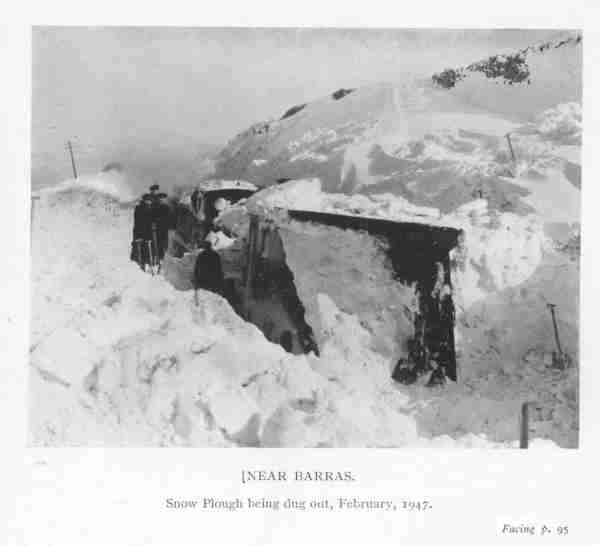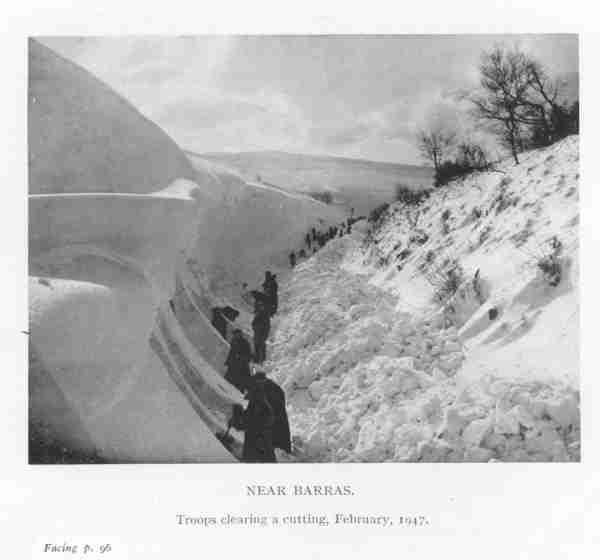A Tour In Westmorland by Sir Clement Jones, published 1948
CHAPTER IX
MIDDLETON - IN - TEESDALE TO
KIRKBY LONSDALE
A RAILWAY JOURNEY - COTHERSTONE - BARNARD CASTLE
BOWES - RERE CROSS - BARRAS - TEBAY - FIRBANK
MIDDLETON-ON-LUNE - BARBON
The next stage of our journey was from Middleton-in-Teesdale to
Kirkby Lonsdale, and we planned to go by rail - by no means as easy an
undertaking as it sounds, owing to the strictly limited services of the local
branch lines by which we travelled. But though the route through the dales was
perforce zig-zag; though the rolling-stock was ancient; though there was no
glass in one of the windows in our compartment; though we stopped at every
station and were so late at the last junction, where we had to change, that we
missed the connection and had to finish the last 15 miles in a taxi,
nevertheless it was by far the most beautiful journey by rail in England that I
have ever taken.
When I lived in New York many years ago I used sometimes on summer evenings to
go down to Coney Island-by-the-Sea, which was at that time America's leading
popular fun-fair. There were acres of swings and roundabouts; whirligigs and
water-shoots; restaurants and amusements; and there was one special attraction
called "The Scenic Railway." This was a combination of switchback and
merry-go-round, which went up and down as well as round and round, to a strident
blare of mechanical music. It was a boxed-up affair, brilliantly lighted and
brightly painted with pictures of mountains, waterfalls, trees and rivers. When
you had recovered from your first feelings of fear and sea-sickness, for the
golden throne on which you sat, as the train rushed ahead with violent jerks,
had little protection to prevent you from falling out and the "motion" was
distinctly marine, you were able to notice the scenes and see whether you were
entering a jungle or passing the Matterhorn.
Even so, magnificent as the Coney Island scenic railway was, I doubt if it could
match the view from Barrass station on the L.N.E.R. line from Barnard Castle to
Tebay. Zig-zag is the only word for that journey from Middleton to Kirkby
Lonsdale; on a map it looks like the letter Z, written by a rather shaky hand.
The top part of the letter is from Middleton to Barnard Castle; the diagonal
part of the Z is from Barnard Castle to Tebay; the bottom part is from Tebay to
Lowgill junction and Kirkby Lonsdale. Middleton is the northern terminus of the
line which runs up Teesdale, and there is some lovely country to be seen from
the carriage window between here and Barnard Castle, especially near Cotherstone
where we had been for a walk earlier in the day. It was here at Cotherstone that
we had gone down to the river and had seen amongst many other flowers, the
alpine bistort (Polygonum viviparum) or persicary growing in some damp ground
beside the Tees. Here too, on the same walk, on the Durham side of the river we
saw woodruff, crosswort, wood sanicle, lady's bedstraw and milkwort. Barnard
Castle was really "off our beat," if we speak as policeman or "not within our
province" if we employ the language of Whitehall, and therefore I shall not
attempt to describe this old town. We merely went there from the Tees side of
the Westmorland boundary in order to get a train back to the district of which
we were making a study.
It was important that we should not miss the connection as there are but two
trains in the day from Barnard Castle to Tebay and one of them had gone already.
We therefore spent a good deal of time hanging about the station, and, when
finally the train did come in, we made the usual rush for it determined, as were
all the other passengers, not to be left behind.
This anxiety proved quite unnecessary, as the train was threequarters of an hour
late in starting and, when it did at last move slowly off, lost a good deal more
time as it went along.
But the lateness of our start was soon forgotten on account of the scenery
through which we were passing. (The delay would be remembered later on when we
reached Tebay). From Barnard Castle the train goes first to Kirkby Stephen via
Bowes and Barras, over the Pennine ridge, so that in recrossing Stainmore Common
from Yorkshire into Westmorland we were reversing by rail what we had done by
car three days previously. The same moorland scenery, the same relatively slow
ascent, up and up from Bowes until we reached the top and saw close to the
railway a signboard inscribed "Stainmore summit. Height 1,370 feet." A real
mountain railway this and no mean height for an English train. Near here, as you
cross from one county into the other, the Bowes-Brough road, the L.N.E.R. line
and the river Greta are all close together, running almost parallel.
At Rere Cross is the ancient boundary cross between England and Scotland in old
times, but now between Westmorland and Yorkshire. A good deal of controversy has
raged round the meaning and the age of this cross. Antiquarians have written
about it; archaeologists have given it much thought. It has been spelt, in
different books, Rey, Rere, Rear, Roy and Ray, according to taste or derivation.
The ordnance map hedges by printing (in old lettering "Rey or Rere Cross."
Nicolson & Burn say:-
"On the top of Stanemore, on the Westmorland side, is the
fragment of a cross, which we call Rere Cross (Rear Cross, a cross reared or set
up) and which the Scots call Roy Cross, as much as to say, the King's Cross;
which Hector Boetius, the Scottish writer, recordeth to have been erected as a
mear stone or boundary between England and Scotland what time King William the
Conqueror granted Cumberland unto the Scots."
In Bulmer's "History and Directory of Westmorland" (1885) it is
spelt Rear Cross; and it is stated that "rere plainly means boundary, i.e. the
end of Scotland and the beginning of England or vice versa." To-day at any rate
it is the beginning of Westmorland or Yorkshire whichever way you look at it.
A little further on beyond the summit and only a little lower down, the train
stops at Barras station. And there on a fine summer evening you wish that it
would stop for an hour, regardless of connections and time-tables, or perhaps
stop for ever, so that you might gaze - from this amazing gazebo of a railway
compartment - as far as you can see, for there spread out in front of you is a
magnificent panorama (there is no other word for it) of the Vale of Eden with an
unbroken view of the surrounding country. Facing north-west you see Brough
straight ahead of you, Warcop Fell and the Pennines on your right, with Appleby
beyond and the Cumberland fells in the far distance.
That was how we saw Barras in June. In winter "quite the other way" the railway
may be blocked with snow and, as may be seen in the photographs supplied for
this chapter by the courtesy of British Railways, a snowdrift can be at once a
menace and a thing of beauty.

Regretfully we left Barras station and the train moved slowly on, first towards
Hartley and then to Kirkby Stephen station which is about half a mile from the
town. Here we changed into another train and it now became certain that we
should miss our connection at Tebay. However, it was a perfect evening, the
scenery remained good and we became
gradually used to the idea that we had missed the last train to Kirkby Lonsdale.
We ran down the Lune Valley through Ravenstonedale station, which is actually at
Newbiggin-on-Lune, and followed the river to Gaisgill and Tebay where we found,
as we had expected, that the train to Lowgill had gone.
At Tebay we had a conference on the platform attended by a guard, a railway
porter and two other passengers who at first appeared as "observers" but later
volunteered views on the lateness of the Company's trains generally and ours in
particular. It was made clear to us first
that there was no other train, secondly that there was no taxi outside the
station, and thirdly that it was doubtful if we could get a bus. After the
conference had broken-up, we were lucky enough to find a helpful postman who had
just seen his mails off by the last train and was adjusting his trouser-clips
before leaving the station to bicycle home. He had been a silent witness at the
last part of the conference but he now came forward and said he had a friend in
the village who owned a car who might be willing to take us to Kirkby Lonsdale
if he had enough petrol. The postman said he would bicycle to the village and
find out what his friend could do; we were to remain in the road outside the
station. There we waited, and after our hopes had been raised in vain more than
once by passing cars, at last the postman's friend arrived. All was well.
The traveller, whether by train or by the Kendal-Appleby road, is apt to think -
and how rightly - of Tebay as a grim and grimy railway junction blackened with
the smoke of many locomotives and consisting mainly of the ugly dwellings of
workmen employed on the railway. But once you get away from the station you are
immediately in a really fine, fell country. Borrowdale, two miles south-west of
Tebay, is truly described in one guide book as "a deep and romantic valley
traversed by a beck, a feeder of the Lune." Originally it formed part of Fawcett
Forest. Low Borrow Bridge, due south of Tebay station, is on the river Lune and
has good fishing. The fells rise high above the river, Jeffrey's Mount on the
west, Tebay Fell on the east. Such was the mountainous country through which we
started our drive from Tebay to Kirkby Lonsdale with the postman's friend. The
main road runs practically due north and south along the line of the Lune. On
previous occasions my wife and I had walked from Grayrigg Common (south of Low
Borrow Bridge) to Middleton-on-Lune so that what we saw this evening, through
the windows of the taxi, was to us familiar ground. From the road near Firbank
you get a good view of the Crook of Lune below you and of the Howgill Fells
across the river to the east. The Church of Firbank, although in the country of
Westmorland, is included in the Diocese of Bradford because the living is united
to that of Howgill in Yorkshire on the other side of the river. On the fell
above the church is a rock known as "Fox's Pulpit" from which George Fox,
founder of the Society of Friends, or the Quakers, in 1652 addressed a
congregation of 1,000 people, some of whom afterwards became leading members of
the Society.
On reaching the Kendal-Sedbergh road we turned sharp to the left in the Sedbergh
direction as our driver said the road was better that way. This took us round by
Ingmire and we rejoined the Kirkby road further on. Next we passed Middleton
station and Middleton Hall which I describe elsewhere

